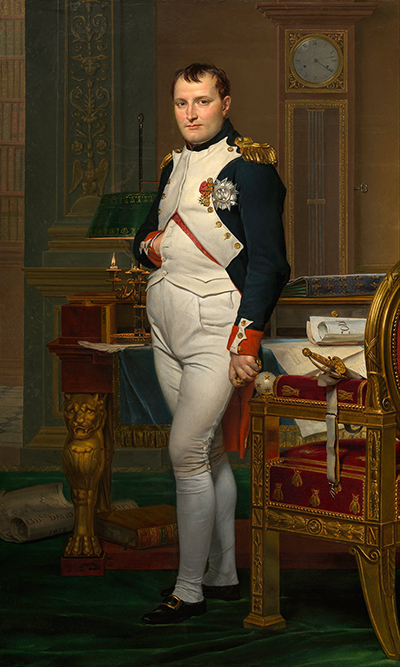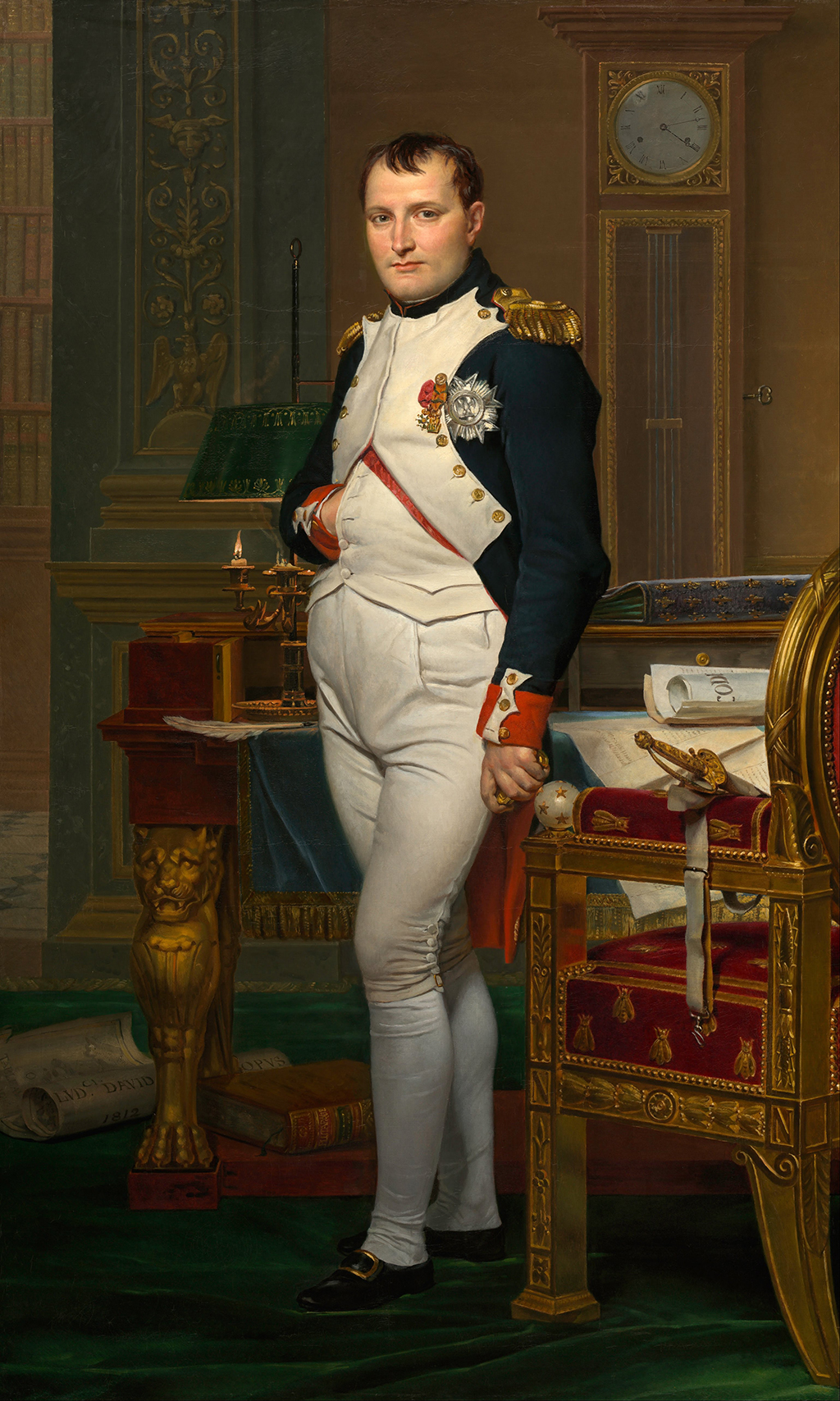The Napoleon Bonaparte in his Study at the Tuileries is a painting standing about three-quarters life-sized which was done by Jacques-Louis David in 1812 with a physical dimension of 1251 centimetre width and 2039 height.
The painting shows Napoleon posing in his study in the Tuileries Palace wearing a colonel’s uniform of the Imperial Guard Foot Grenadiers. The painting also shows Napoleon wearing his Legion d’honneur and Order of the Iron Crown medals. He also wears gold epaulettes with white French-style culottes and white stockings. The painting illustrates Napoleon facing the viewers with his right hand inside his jacket.
Napoleon appears to pose after working the whole night on the Code Napoleon, a civil code filled with laws to govern his empire. The work he has been doing throughout the night is illustrated by the quill pen which is on the left side of the desk, the writing paper laying on the opposite side of the desk and the scroll which has letters ‘COD’ which is the Code Napoleon.
The painter portrayed that Napoleon has been working the whole night writing the laws since his cuffs are unbuttoned, he has wrinkled stockings, his hair is dishevelled with a flickering candle and the clock on the wall showing the time is 4:13 am. Jacques-Louis David on this painting strategically placed the sword on the chair to portray the military success of Napoleon. The word ‘Code’ is prominently displayed on his papers on the table, thus suggesting the achievements he has made in administration.
When the original painting is analysed, it will be seen that the artist re-edited the work of art and details a number of times in order to balance the image and capture the entire story. The strokes of brush and texture illustrate that the original version had the upper body of Napoleon flanked by two fluted columns whose width is approximately the figure’s torso. The columns were re-edited into a carved panel in shadow with a large clock on the wall included. The revision of the entire painting significantly enhanced the compositional balance of the upper section painting and the reduction of an impression of the three vertical columns. The revision successfully moved the focus of viewers from the presumably accurate stature to the face and expression of Napoleon.
The artist, Jacques-Louis David in his painting of Napoleon in his study at the Tuileries symbolises a lot. Every element the artist included in the painting had a hidden meaning to express something. From the painting, the artist wanted to portray Napoleon as a more upright and honest man. The artist wanted to describe Napoleon as a hardworking man who has worked tirelessly for his empire to ensure it has grown and remained stronger.
The artist purposely included a wall clock with time 4:13 am with a candle which is almost dying off thus indicating Napoleon has been working through the deep night. To further suggest that Napoleon was working hard, the artist painted the hair of Napoleon to appear unkempt, wrinkled stocking with the unbuttoned uniform. The artist also includes a snuffbox on the right hand of Napoleon to illustrate that he used tobacco to keep him awake throughout the night as he works. The military décor on his uniform and the sword on the chair were included on the painting to indicate the success of Napoleon as a military leader. There is also the inclusion of the golden bees on the chair to show the diligence of Napoleon.
The Napoleon Bonaparte in his study at the Tuileries was privately commissioned by a Scottish nobleman who has always been an admirer of Napoleon, Alexander Hamilton, 10th Duke of Hamilton in 1811 and completed in 1812 by Jacques-Louis David. Alexander Hamilton admired Napoleon because of his power and how he governed his empire and asked the artist to “move the features of a great and heroic man onto the canvas, and represent Napoleon in one of the most historic moments which have made him immortal”.
The Duke of Hamilton gave the artist the go-ahead, and he was free and had many options to choose for the content of the painting, and he even had the liberty to decide how much the Duke of Hamilton will pay him for the painting. The artist happily accepted the commission and went ahead to complete it and gained recognition outside France. The Napoleon Bonaparte in his study at the Tuileries painting was initially shown at the Hamilton Palace. It was then sold to Archibald Primrose of Rosebery in 1882 and later bought by Samuel H. Kress Foundation in 1954. The Kress Foundation decided to deposit the painting in National Gallery of Art in Washington DC, where it currently hangs.
It is well worth examining the styles of other artists such as Eugene Delacroix, Theodore Gericault, Gustave Courbet and Francisco de Goya in order to place Jacques Louis David more accurately within the context of European art history.





